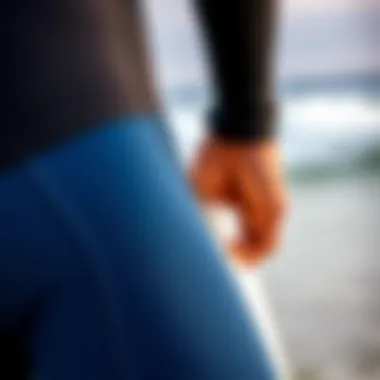Choosing the Ideal Shorty Wetsuit for Surfing


Intro
In the unpredictable world of surfing, where every wave tells a different story, the right gear can't be overstated—especially when it comes to your wetsuit. A shorty wetsuit is often the go-to choice for many surfers, offering a perfect balance of flexibility, warmth, and ease of movement. This article will dive into the nitty-gritty of selecting the best shorty wetsuit for your surfing endeavors. Whether you’re just starting out or you’ve been riding the waves for years, understanding what to look for in a wetsuit can substantially enhance your overall experience.
In this exploration, we’ll break down crucial considerations — from the materials that keep you warm to the fit that keeps you agile, along with tips on how to maintain your wetsuit for longevity. By the end of this guide, you'll have the insights necessary to make an informed choice, ensuring your surfing adventures are both thrilling and comfortable.
Surfing Techniques
Beginner Tips for Getting Started
As a budding surfer, feeling at home on the water can be daunting. Knowing the basics is paramount. Start by understanding how to paddle efficiently. Keep your body centered on the board; pushing too hard with your arms can throw your balance off. It’s also vital to practice popping up – that’s the transition from lying down to standing on your board. This skill may take some time to perfect, but patience is key. Knowing when to catch a wave is another critical aspect. Look for smaller swells if you're just starting, as they provide an easier ride while you gain confidence.
Advanced Maneuvers and Tricks
For those who’ve surfed long enough to feel comfortable, it’s time to kick it up a notch. Tricks like the cutback and the bottom turn are essential to mastering more dynamic surfing styles. To perform a cutback, lean into the wave, turning your board back toward the whitewater. This maneuver helps you maintain speed while negotiating the ever-changing waters. Advanced surfers often incorporate aerial moves, such as the ollie or floaters, where you launch yourself off the lip of the wave briefly. These techniques require practice and commitment, but they're incredibly rewarding once mastered.
Wetsuit Considerations
When considering which shorty wetsuit suits your surfing style best, you will want to dive into some key characteristics, including:
- Material Quality: Look for neoprene that offers both warmth and flexibility. Higher-grade models use super-stretch or limestone-based neoprene for enhanced comfort.
- Fit: A wetsuit should feel like a second skin. If it's too tight, you'll struggle to catch waves; too loose, and you'll get cold.
- Insulation: Thickness matters. A shorty wetsuit usually ranges from 1.5mm to 3mm thick, depending on the water temperature you’ll be surfing in.
- Seams: Pay attention to the stitching. Flatlock stitching is common in warmer, comfortable suits, while glued and blind stitched seams provide better insulation for colder waters.
Remember: Each surfer’s needs vary based on personal preference and geographical conditions. What excels in warm waters may not hold up in the frigid Caribbean seas.
Brands Worth Exploring
Brand loyalty can play a role, but knowing which brands have earned respect in the surfing community can direct your search. Consider ditching the guesswork by looking at:
- O’Neill: A pioneer in wetsuit technology, known for quality and performance.
- Rip Curl: Offers a wide array of wetsuits tailored for all season surfing.
- Billabong: Known for trendy designs, they balance functionality and style.
Each brand has its hallmark features, tailoring to individual preferences. Trying a few different suits can be beneficial until you find your holy grail.
Surfboard Selection
Choosing the Right Board for Your Style
Your shorty wetsuit will pair with your surfboard—not just in how they fit your needs but also in how they complement your surfing style. A smaller, more agile board may suit explosive maneuvers, while a longboard provides stability for leisurely rides. Think about what you enjoy about surfing. If you lean toward tossing tricks and catching quick waves, a shortboard might be your best bet. Alternatively, if cruising and paddling ease is your vibe, a funboard could be the ticket.
Surfboard Maintenance and Care
Having a quality surfboard will not mean a thing if you neglect its care. Rinse your board off with fresh water after each surf session to remove any sand or salt that could cause wear over time. Store it out of direct sunlight, as prolonged exposure can dull your board’s finish and weaken it structurally. Regular inspections for dings or cracks ensure that your board stays in top shape for the next adventure.
This thorough examination ensures not just longevity but optimal performance, pairing your shorty wetsuit with a surfboard that matches its dynamic potential.
Understanding Shorty Wetsuits
When it comes to surfing, the right gear can make or break your experience. Understanding shorty wetsuits is crucial for anyone looking to hit the waves comfortably. These suits, which usually have short sleeves and legs, are designed explicitly to offer both warmth and flexibility in warmer water conditions. They provide an excellent balance for surfers who want to maintain mobility without sacrificing too much insulation. In this article, we will delve into the particulars of shorty wetsuits and outline their significance in enhancing your surfing adventures.
What is a Shorty Wetsuit?
A shorty wetsuit, sometimes known informally as a short-sleeve wetsuit or spring suit, is tailored for those who surf in warmer climates or during the summer months. This type of wetsuit typically covers the torso while leaving the arms and legs exposed, facilitating greater freedom of movement—ideal for catching waves.
Unlike full wetsuits that enclose the entire body, shorty wetsuits allow surfers to keep cool while still providing a layer of protection against wind, mild impacts, and stings from marine creatures. They often come in varying thicknesses, commonly between 1.5mm and 3mm, allowing for versatility depending on the water temperature. The right shorty can make a world of difference on a hot day when you want to prolong your time in the water without overheating.
Key Features of Shorty Wetsuits
Shorty wetsuits come packed with several features that differentiate them from other types of wetsuits. Here are some of the key elements you should consider:


- Material Quality: The best shorty wetsuits are crafted from high-grade neoprene that provides both insulation and flexibility. Look for materials that offer a good balance between stretch and durability.
- Design: Shorty wetsuits have several designs tailored for different surf styles. Some may feature back zippers while others may have chest zippers, allowing surfers to choose based on convenience and ease of getting in and out.
- Fit: A snug yet comfortable fit is crucial. The suit should feel like a second skin, limiting water entry while enabling movement. Models come in various sizes catering to both men and women.
- Seam Types: It's worth paying attention to seams. Flatlock seams are often employed for warmth and durability, while blind-stitched seams are excellent for providing an extra layer of thermal insulation.
- Versatility: Many models can be used for not just surfing but other water sports like kayaking or paddleboarding, making them multipurpose as well.
With these elements, shorty wetsuits stand out as a practical option for surfers who value comfort and flexibility in warmer waters. They strike a fine balance, offering just enough warmth without feeling constricting.To maximize your performance while surfing, understanding these features is essential in making the right choice.
"Having the right shorty wetsuit means you can focus on the waves instead of the cold—surfing is all about the ride!"
Equipped with this understanding, let's dive deeper into the importance of wetsuit selection specifically for surfing.
Importance of Wetsuit Selection in Surfing
Choosing the right wetsuit for surfing is not merely about staying stylish on the waves; it’s a fundamental decision that can drastically impact a surfer's experience. The selection process involves more than just aesthetics; it directly relates to comfort, thermal protection, and performance. A well-chosen wetsuit acts as a barrier between the body and the water, allowing surfers to stay in the ocean longer, ride those waves with confidence, and enjoy their time without constant distractions.
Comfort and Fit
When it comes to surfing, comfort is king. A wetsuit needs to fit like a glove. If it’s too loose, water can seep in, causing the surfer to feel cold and sluggish as the body struggles to maintain warmth. Conversely, if it’s too tight, mobility can be restricted, limiting the athlete's ability to paddle out or maneuver effectively on the board.
An ideal fit ensures that the wetsuit doesn’t constrict movement yet provides enough support to maintain warmth. Look for sizing guides offered by different brands, as measurements can vary significantly. Pay close attention to the thickness, neck seal, and wrist seals, as these features also play crucial roles in achieving proper fit and comfort. Remember, it’s all about finding joy in those waves—miserable fit can ruin the vibe.
"The right fit should feel like a second skin, allowing you to ride without holding back."
Heat Retention
Maintaining body heat in cooler waters is vital for peak performance, as hypothermia can set in quicker than one might expect. Wetsuits function by trapping a layer of water between the suit and the skin. This water warms up from body heat, providing insulation. This phenomenon is particularly critical in chilly ocean temperatures, where a surfer can lose core body temperature rapidly.
Look for wetsuits with advanced neoprene technologies; brands are now integrating insulating materials such as Yamamoto neoprene, which provide better thermal efficiency without compromising flexibility. If surfing in frigid waters, thicker wetsuits (3/2mm or even 4/3mm) can be crucial in ensuring a more enjoyable and safe experience. A wetsuit designed for heat retention allows surfers to focus on their ride instead of on freezing fingers or shivering limbs.
Weather Conditions
Considering weather conditions is paramount when selecting a wetsuit. Factors such as air temperature, water temperature, and wind can all inform the best choice for surf outings. For instance, in tropical and warm conditions, a lighter shorty wetsuit may suffice, while cooler regions might call for suits with thermal linings or additional insulation.
Surfers should also be mindful of the wind’s impact. A brisk wind can make an otherwise warm day feel quite chilly, so opting for a suit that provides more coverage—which is sometimes overlooked in warmer waters—might be necessary to combat that wind chill. Evaluating environmental factors ensures that surfers invest in the right wetsuit, preventing unnecessary discomfort and enhancing their overall experience.
By understanding the significance of wetsuit selection, surfers can make informed decisions that elevate their time on the waves, allowing them to focus on honing their skills and enjoying the water.
Key Materials in Shorty Wetsuits
Selecting the right materials for a shorty wetsuit is crucial for ensuring both performance and comfort while surfing. The materials used not only determine the flexibility and fit of the wetsuit but also play a significant role in heat retention and durability. A well-constructed wetsuit can make all the difference between a pleasant session on the waves and an uncomfortable experience that leaves you shivering.
In essence, it’s about understanding how each component contributes to your overall surfing experience. From the effectiveness in maintaining body temperature while submerged in cold water to the ease of movement in each stroke, these materials need to work harmoniously together. Let's dive into the most common materials used in shorty wetsuits to understand their distinct features and advantages.
Neoprene Variations
Neoprene is the most widely used material in wetsuits, and for good reason. It’s like the backbone of the wetsuit world. This synthetic rubber provides excellent insulation as well as flexibility, making it an ideal choice for surfers who need to paddle, twist, and turn easily on their boards.
- Standard Neoprene: Generally thicker and great for colder waters. However, it may restrict movement, especially for those just starting out.
- Limestone Neoprene: A more eco-friendly option derived from limestone instead of petroleum. Many brands are moving towards limestone due to its better buoyancy and flexibility.
- Super Stretch Neoprene: This type offers exceptional stretch. Perfect for active surfers as it allows for maximum range of motion. Though more expensive, the comfort it provides can be worth the investment.
Neoprene thickness can range from as thin as 1.5 mm to about 3 mm, depending on the water temperature. For warmer climates, a thinner shorty might do the trick, while colder regions might necessitate a thicker one. It's worth mentioning that some surfers will opt for a combination during transitional seasons, using a thicker suit for the torso and thinner for limbs to maintain warmth without sacrificing mobility.
Seams and Construction
The construction of a wetsuit is just as essential as the material it’s made from, specifically the seams. Think of seams like the stitching in a fitted suit; proper construction can significantly affect how well a wetsuit performs in the water.
There are a few different seam types to be aware of:
- Flatlock Seams: Often found in warmer water suits, these seams lay flat against the body and are breathable. However, they aren’t entirely watertight, so might not be suitable for colder water.
- Glued and Blind Stitched Seams: For cooler temps, these seams are sealed and offer better insulation while keeping water out. This method uses glue to bond the layers together, which reduces the risk of water seepage.
- Taped Seams: The best option regarding durability and water resistance. Flexible tape strengthens seams against wear and tear, perfect for surfers who frequently find themselves in rocky or turbulent waters.
Overall, the quality of seams affects the longevity and performance of a wetsuit. Paying attention to these details during your purchase can save hassle down the road. A well-sealed and carefully constructed wetsuit leads to not just comfort, but also a better surfing experience.


Important Note: When trying on a wetsuit, it's vital to consider how it feels in the water. A snug fit without restricting movement is best, so test it in a pool or at the beach before committing fully.
By understanding these key materials and construction methods, you can make a more informed decision about what type of shorty wetsuit will fit your surfing style and the conditions you'll encounter out on the waves.
Evaluating the Best Brands
In the realm of surfing, selecting the right equipment can mean the difference between a thrilling ride and a bitter disappointment. This is particularly true when it comes to shorty wetsuits. The brands available today have dedicated substantial effort into redefining the standards of performance, comfort, and durability. Understanding the best brands in the market is crucial for surfers seeking reliability and quality. Knowing which brands have a history of delivering exceptional products can save time and help avoid pitfall purchases that could affect your overall experience in the water.
Industry Leaders in Wetsuits
When we think of top-tier wetsuit brands, a few standout names come to mind. These companies have built their reputations on years of expertise, quality craftsmanship, and constant innovation. Brands like O'Neill, Rip Curl, and Billabong have not only pioneered technologies that enhance the surfer’s experience but also understand the diverse needs of different surfer demographics. For example, O'Neill is known for its FluidFlex technology, which offers exceptional stretch while maintaining warmth. Likewise, Rip Curl’s E-Bomb wetsuit line focuses on flexibility, providing surfers the necessary freedom to carve and navigate waves effortlessly.
Moreover, these brands often engage in rigorous testing and development involving professional athletes, ensuring that their products withstand the demands of serious surf conditions.
- O'Neill: Pioneered wetsuit designs and technology, focusing on warmth and flexibility.
- Rip Curl: Offers a great balance of performance features for advanced surfers.
- Billabong: Known for its stylish options while ensuring high performance with its materials.
Niche Brands Worth Considering
Perhaps you're looking to venture beyond the industry giants. Exploring niche brands can bring surprising value. Brands like Vissla and Patagonia are making waves for their unique offerings and philosophies. Vissla specializes in products that cater to the environmentally-conscious surfer, with a commendable focus on sustainable materials and ethical practices. This is crucial for surfers who want their gear to reflect their values.
On the other hand, Patagonia excels in producing wetsuits using limestone-based neoprene, which is a more sustainable and environmentally friendly option. They are known for their durability and commitment to repairing or replace worn-out products, ensuring that their wetsuits have a longer lifecycle. This is a great bonus for individuals keen on reducing waste.
- Vissla: Environmentally friendly designs that focus on sustainability.
- Patagonia: Combining performance with eco-awareness.
- Xcel Wetsuits: Known for high-quality neoprene and thermal insulation, making it ideal for colder waters.
By examining both the industry leaders and niche brands, surfers can make informed decisions tailored to their specific needs and preferences, from beginners looking for value to seasoned pros seeking advanced performance.
Top Shorty Wetsuit Recommendations
When it comes to surfing, having the right gear can make or break your experience out on the waves. The focus here is on selecting shorty wetsuits tailored for various needs, ensuring surfers are well-equipped whether they're just starting or are seasoned pros. A well-fitted wetsuit boosts comfort, protects against chilly waters, and allows for optimal movement, so let's delve into what you need to consider in these recommendations.
Shorty Wetsuit for Beginners
For those new to surfing, the journey into the ocean wave shouldn't feel like jumping into the deep end. Finding a shorty wetsuit that balances comfort and protection is key. Look for features like:
- Thickness: Generally, a 2mm thickness is a good choice for warmer waters. It allows for flexibility while providing sufficient insulation on cooler days.
- Flatlock seams: They offer decent durability and flexibility, preventing water from seeping in too much during those inevitable wipeouts.
- Easy entry and exit: A zippered back or front-entry design makes it easier to put on and take off.
One highly recommended option is the O'Neill Wetsuits Reactor II. It’s user-friendly for beginners, with a price point that doesn’t hit the pocket too hard. Beginners often find comfort in its fit, which allows them to focus more on honing their skills than fussing over their gear.
Advanced Shorty Wetsuits
As skills advance and surfers seek to maximize their performance, they will benefit from wetsuits with enhanced features. Experienced surfers often demand more from their gear, particularly in terms of:
- Thermal Technology: Advanced versions may include materials that retain heat better without sacrificing flexibility.
- Seam technology: Expect to see glued and blind-stitched seams that offer superior durability and minimize water entry.
- Neoprene quality: High-quality neoprene like Limestone or super-stretch for ultimate freedom of movement can greatly improve the surfing experience.
A top contender in this space is the Rip Curl Flashbomb. This wetsuit features a unique quick-dry lining, so even after a full day of surfing, it remains lightweight when putting it back on. Surfers appreciate the snug fit and thermal properties, allowing for longer surf sessions without feeling the chill.
In both novice and advanced models, the right fit is crucial. Test the fit by checking for any loose areas that may allow water to enter, as this can become quite uncomfortable. Your choice in wetsuit creates a direct line to your enjoyment in the water, leading ultimately to improved performance and greater confidence as you conquer the surf.
The right shorty wetsuit not only enhances performance but ensures a more enjoyable surfing experience.
When it comes to the top recommendations, there’s a balance to strike between your skill level, the water conditions you’ll be surfing in, and the type of fit that works best for your body. Taking these elements into account can lead to solid choices suitable for any surfer's needs.
Performance Comparisons
In the pursuit of the ultimate surfing experience, the importance of assessing performance in shorty wetsuits cannot be understated. Performance comparisons involve evaluating various aspects that affect how a wetsuit will function in real-world conditions. This includes thickness, flexibility, durability, and thermal regulation. Understanding these elements can make or break a surfer's day out on the waves.
When it comes to shorty wetsuits, durability and comfort are primary concerns for many surfers. A wetsuit that holds up against the wear and tear of crashing waves while keeping its wearer comfy can substantially enhance a surfing session. It’s not just about protection from the cold; it’s about optimizing one's ability to perform on the board without being hindered by an ill-fitting or poorly constructed wetsuit.


"A good wetsuit should feel like a second skin, allowing unrestricted movement while keeping you warm without stifling."
Evaluating performance based on different criteria helps surfers choose a wetsuit that best suits their unique needs, whether they are just beginning their surf journey or are seasoned pros.
Wetsuit Thickness Comparisons
Wetsuit thickness directly influences buoyancy, insulation, and movement in water. Shorty wetsuits typically come in a range of thicknesses, with the common choices being 2mm and 3mm. The choice between these thicknesses often hinges on the surf conditions where the wearer will be riding.
- 2mm Wetsuit: Ideal for warmer waters, these suits provide enough insulation without sacrificing flexibility. Surfers can move freely and take on waves comfortably, making it a popular choice for summer surfing.
- 3mm Wetsuit: Better suited for cooler waters, the extra thickness offers enhanced warmth but can restrict movement a tad. It’s often preferred in transitional seasons or in areas where water temperatures drop significantly.
Ultimately, selecting the right thickness helps balance warmth and flexibility, assuring that surfers can perform at their best regardless of conditions.
Price Versus Performance
When choosing a shorty wetsuit, the old adage "you get what you pay for" holds significant weight. Price often correlates with performance – higher-priced wetsuits tend to use advanced materials and construction methods that optimize elasticity and durability.
However, price isn't the only factor to consider. Here’s what to think about:
- Material Quality: Premium brands invest in high-quality neoprene that maintains heat better and offers greater durability.
- Brand Reputation: Well-known brands have built credibility over years, often providing better warranties and customer service.
- User Feedback: Insights from fellow surfers can make it easier to weigh whether a higher price equates to a better experience on the waves.
While it might be tempting to opt for the least expensive option, it’s crucial to consider how the price aligns with the performance benefits offered. In many cases, investing in a well-made shorty wetsuit pays dividends in longevity and comfort in surf outings.
Care and Maintenance of Shorty Wetsuits
Keeping your shorty wetsuit in tip-top shape ensures that it performs well during those exhilarating surfing sessions. Regular care and maintenance extend the lifespan of the suit and preserve its insulating properties, allowing you to ride the waves comfortably. Neglecting to properly care for your wetsuit can lead to wear and tear, reducing both its performance and your overall experience in the water.
Cleaning and Drying Techniques
Giving your shorty wetsuit a thorough clean after each use is crucial. Saltwater and sand can wreak havoc on the materials, dulling their elasticity and insulation. Here’s how to clean it right:
- Rinse with Fresh Water: After leaving the water, rinse your wetsuit inside and out with fresh, cool water. This simple act removes salt, sand, and grime, preventing any buildup.
- Gentle Soap Use: For a deeper clean, use a wetsuit-specific soap or a gentle dish soap. Avoid harsh detergents or additives that can break down neoprene. Lather up the suit lightly – it’s not a car wash, just a gentle rub.
- Cold Water Wash: If the suit needs a more intense clean, you might consider soaking it in cold water mixed with wetsuit shampoo. Remember, this isn’t like throwing your clothes in the wash. Let it soak for about 20-30 minutes.
- Avoid Excessive Heat: After cleaning, it’s time to dry the wetsuit. Turn it inside out and hang it on a molded hanger. Never place it in direct sunlight or near a heater, as excessive heat can cause the neoprene to break down.
Use a shade drying method when possible. A shady spot allows airflow without the harsh rays beating down, which also helps maintain the suit's color.
Storage Recommendations
Proper storage is just as vital as cleaning and maintaining your wetsuit. A well-stored wetsuit doesn't just prevent damage, it keeps everything fresh for when you're ready to conquer the waves again. Here are some golden rules:
- Dry Before Storing: Ensure the wetsuit is completely dry before putting it away. Moist conditions can encourage mold and mildew growth, making your next use less than pleasant.
- Use a Wetsuit Bag: Investing in a wetsuit bag can provide extra protection from dust and dirt. Look for something breathable to keep the suit from becoming soggy over time.
- Avoid Folding: Never fold the wetsuit as that can create creases and weaken the material over time. Instead, hang it up in a cool, dry place.
- Temperature Regulation: Store in an environment where the temperature is cool, avoiding extreme heat and cold, maintaining the integrity of the neoprene material.
By incorporating these care techniques, surfers can ensure their shorty wetsuits remain effective and last much longer. Visit Wikipedia for more insights on wetsuit care routines that have been developed by surfing experts over the years.
End
When it comes to selecting a shorty wetsuit for surfing, the conclusions drawn throughout this article are pivotal for any surfer with aspirations to catch waves comfortably and effectively. The shorty wetsuit, designed with strategic functionality in mind, offers a fantastic balance between mobility and insulation, allowing surfers to maintain their skills while basking in warmth on chillier days.
Choosing the Right Wetsuit for Your Needs
The primary takeaway is that choosing the right wetsuit hinges not just on personal style but also on practical fit, the specific conditions you’ll be surfing in, and your individual body type. It's crucial to assess these variables:
- Fit: Ensure the wetsuit is snug but not restrictive. A well-fitted wetsuit should feel like a second skin.
- Thickness: Pick the appropriate thickness based on water temps you’re most often in. Thinner suits work well in warmer waters, while thicker suits are a go-to for colder conditions.
- Brand Reputation: Certain brands, such as Rip Curl and O'Neill, stand the test of time, consistently delivering quality and innovation. Do your research to find the right match.
- Type of Surfing: Are you gracing the waves as a beginner, or are you already hitting them with advanced moves? Factor in what type of surfing you plan to do.
Your choice of wetsuit directly affects both performance and comfort. It can’t just be about looking cool; it needs to serve a purpose fitting to your surfing lifestyle. Smart choices lead to better experiences, allowing for unfettered freedom on the water, which is what every surfer aims for.
Final Thoughts on Shorty Wetsuits
In summary, shorty wetsuits represent a blend of protection and freedom. They are essential gear for those who wish to surf without being hindered by cold or excessive water drag. When selecting a wetsuit, don’t rush into buying the first one that catches your eye. Instead, consider the fabric’s composition, the seams' quality, and the overall construction.
"The best wetsuit is the one you don’t notice while surfing." This adage rings true—comfort and flexibility lead to a better surfing experience.
Take the time to explore various models, conduct careful evaluations, and possibly even try them on if you can. Only then can you ensure you’ve made an informed and suitable choice that elevates your surfing game. Whether you’re new to surfing or a seasoned pro, the right shorty wetsuit can make all the difference between an average day and an unforgettable surfing adventure.
By considering everything discussed in this article—from material choices to maintenance tips—you can confidently leap into the waves, knowing that you’re geared up for success.



